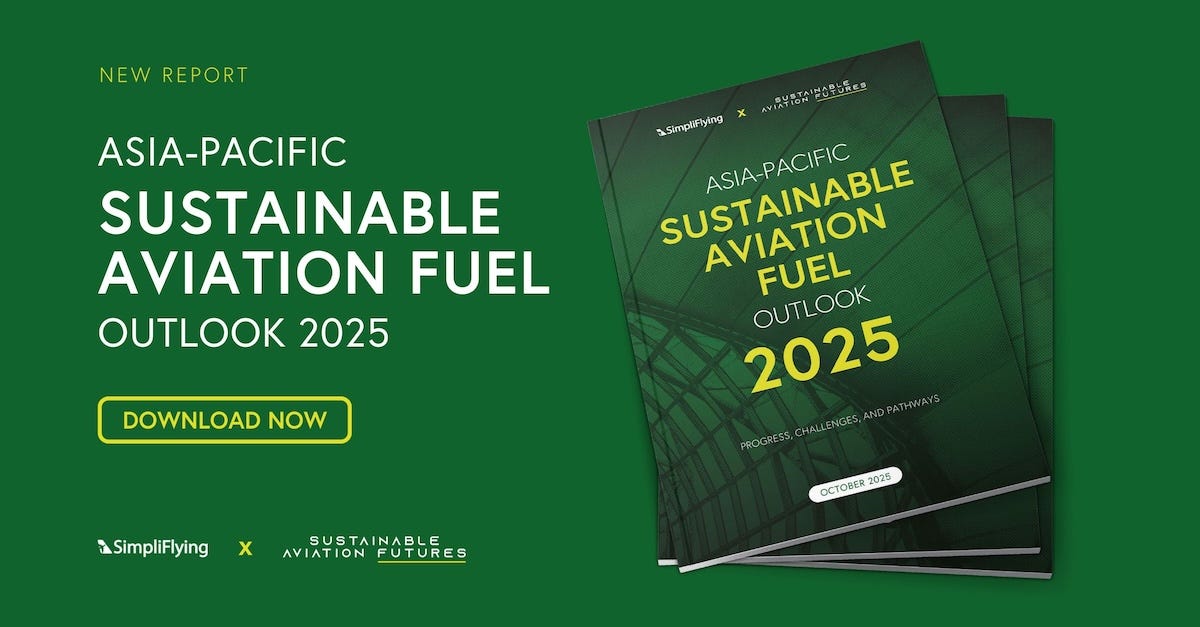New Report: Asia-Pacific Sustainable Aviation Fuel Outlook 2025
A closer look at the mandates, investments, and partnerships reshaping sustainable aviation fuel in the world’s fastest-growing aviation market.
From 24 to 26 November, Singapore will host the Sustainable Aviation Futures Asia-Pacific Congress 2025, bringing together over 400 leaders from across aviation, energy, and finance to chart the region’s path to net-zero flight. The event comes at a defining moment for the Asia-Pacific (APAC) aviation sector: after years of discussion, the region is finally shifting from SAF planning to SAF production.
Ahead of the event, we’ve released a new report – Asia-Pacific Sustainable Aviation Fuel Outlook 2025 – that maps the APAC region’s policy breakthroughs, emerging capacity, and capital flows. The report finds a region in rapid transition: 2025 is the year APAC moves from aspiration to action.
The Asia-Pacific region is home to nearly 40% of global aviation traffic, making it central to any meaningful decarbonisation of air travel.
Historically, APAC has lagged North America and Europe in sustainable aviation fuel (SAF) uptake, in large part because policy drivers and commercial initiatives were slower to develop here.
In 2025, APAC stands at a crossroads where it can transform from a passive consumer of others’ SAF into an active producer and leader in sustainable fuel.
From goals to mandates
Since 2024, multiple APAC governments have moved from tentative goals to concrete blending targets and mandates:
Japan leads with a binding 10% SAF mandate by 2030, supported by subsidies and a dedicated SAF Taskforce.
Singapore has committed to 1% SAF for all flights by 2026, rising to 3–5% by 2030.
India has blending targets of 1% by 2027 and 2% by 2028 for international flights, backed by new certification standards.
Indonesia, Malaysia, and Thailand each unveiled roadmaps beginning around 2026–2027, while South Korea confirmed its first mandatory 1% blend by 2027 for departing flights.
Investment momentum and industrial partnerships
Australia’s newly announced A$1.1 billion Cleaner Fuels Programme, a ten-year fund to support low-carbon fuels, is the region’s first large-scale government subsidy for SAF. Similar public support is emerging in Japan and Singapore, while Indonesia and Malaysia are preparing fiscal incentives tied to their mandates.
Private financing alliances have also taken shape. The Qantas-Airbus Sustainable Aviation Fuel Financing Alliance (SAFFA) has raised around US$200 million, investing in projects across the U.S. and APAC. Meanwhile, oneworld member airlines joined forces with Singapore Airlines and Breakthrough Energy Ventures to launch a US$150 million fund in 2025 to accelerate SAF technology commercialisation.
Key insights from the report
Policy turning point: Nine APAC countries have formal SAF targets; mandates in Japan, Singapore, and South Korea are enforceable by 2027.
Industrial scale-up underway: Regional SAF capacity has expanded sharply, led by Singapore, China, and Japan, with multiple new plants due before 2030.
Investment acceleration: Australia’s A$1.1 billion fund and airline-financier alliances like the SAFFA mark the arrival of serious capital behind SAF in APAC.
Feedstock abundance, certification gap: Asia’s waste oils and residues offer unmatched supply potential, but sustainability verification remains uneven.
Why this matters
Globally, SAF still accounts for less than 1% of total jet consumption. To meet 2030 climate goals, production must scale hundredfold.
If current targets are met, APAC’s SAF supply could reach 1.7 billion gallons by 2030, positioning it as the largest SAF market in the world by 2040. But that outcome depends on the next two years: policy execution, feedstock logistics, and investment alignment between governments and industry.
As our report concludes, this is the decade when planning turns to production, and the APAC region’s energy transition takes flight.




